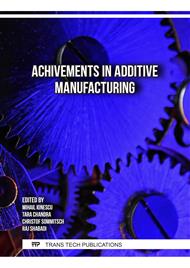[1]
K. Simunovic, T. Saric, G. Simunovic, Different Approaches to the Investigation and Testing of the Ni-Based Self-Fluxing Alloy Coatings—A Review. Part 1: General Facts, Wear and Corrosion Investigations, Tribol. Trans. 57 (2014) 955–979.
DOI: 10.1080/10402004.2014.927547
Google Scholar
[2]
S. Lebaili, M. Durand-Charre, S. Hamar-Thibault, The metallurgical structure of as-solidified Ni-Cr-B-Si-C hardfacing alloys, J. Mater. Sci. 23 (1988) 3603–3611.
DOI: 10.1007/BF00540502
Google Scholar
[3]
T. Liyanage, G. Fisher, A.P. Gerlich, Influence of alloy chemistry on microstructure and properties in NiCrBSi overlay coatings deposited by plasma transferred arc welding (PTAW), Surf. Coat. Technol. 205 (2010) 759–765.
DOI: 10.1016/j.surfcoat.2010.07.095
Google Scholar
[4]
I. Hemmati, J.C. Rao, V. Ocelík, J.T.M. De Hosson, Electron microscopy characterization of Ni-Cr-B-Si-C laser deposited coatings, Microsc. Microanal. Off. J. Microsc. Soc. Am. Microbeam Anal. Soc. Microsc. Soc. Can. 19 (2013) 120–131.
DOI: 10.1017/S1431927612013839
Google Scholar
[5]
A. Vafadar, F. Guzzomi, A. Rassau, K. Hayward, Advances in Metal Additive Manufacturing: A Review of Common Processes, Industrial Applications, and Current Challenges, Appl. Sci. 11 (2021) 1213.
DOI: 10.3390/app11031213
Google Scholar
[6]
H. Zheng, H. Li, L. Lang, S. Gong, Y. Ge, Effects of scan speed on vapor plume behavior and spatter generation in laser powder bed fusion additive manufacturing, J. Manuf. Process. 36 (2018) 60–67.
DOI: 10.1016/j.jmapro.2018.09.011
Google Scholar
[7]
I. Shishkovsky, N. Kakovkina, V. Sherbakof, Mechanical properties of NiCrBSi self-fluxing alloy after LPBF with additional heating, Procedia CIRP. 94 (2020) 217–221.
DOI: 10.1016/j.procir.2020.09.041
Google Scholar
[8]
W.Q. Wang, Y.Q. Li, X. Li, L. Liu, F. Chen, Microstructures and properties of Ni-Cr-B-Si alloy powders prepared by selective laser melting, Mater. Rep. 34 (2020) 2077–2082.
Google Scholar
[9]
F. Abe, K. Osakada, M. Shiomi, K. Uematsu, M. Matsumoto, The manufacturing of hard tools from metallic powders by selective laser melting, J. Mater. Process. Technol. 111 (2001) 210–213.
DOI: 10.1016/S0924-0136(01)00522-2
Google Scholar
[10]
F. Wang, H. Mao, D. Zhang, X. Zhao, Y. Shen, Online study of cracks during laser cladding process based on acoustic emission technique and finite element analysis, Appl. Surf. Sci. 255 (2008) 3267–3275.
DOI: 10.1016/j.apsusc.2008.09.039
Google Scholar
[11]
L. Liu, W. Wang, X. Zhang, X. Li, Y. Tian, X. Zhao, Microstructures and mechanical properties of Nb nanoparticles modified Ni60 hard-facing alloy fabricated by laser metal deposition, Mater. Sci. Eng. A. 814 (2021) 141238.
DOI: 10.1016/j.msea.2021.141238
Google Scholar
[12]
B. Liu, B.-Q. Li, Z. Li, Selective laser remelting of an additive layer manufacturing process on AlSi10Mg, Results Phys. 12 (2019) 982–988.
DOI: 10.1016/j.rinp.2018.12.018
Google Scholar
[13]
K. Wei, M. Lv, X. Zeng, Z. Xiao, G. Huang, M. Liu, J. Deng, Effect of laser remelting on deposition quality, residual stress, microstructure, and mechanical property of selective laser melting processed Ti-5Al-2.5Sn alloy, Mater. Charact. 150 (2019) 67–77.
DOI: 10.1016/j.matchar.2019.02.010
Google Scholar
[14]
E. Yasa, J.-P. Kruth, J. Deckers, Manufacturing by combining Selective Laser Melting and Selective Laser Erosion/laser re-melting, CIRP Ann. 60 (2011) 263–266.
DOI: 10.1016/j.cirp.2011.03.063
Google Scholar
[15]
H. Ali, H. Ghadbeigi, K. Mumtaz, Effect of scanning strategies on residual stress and mechanical properties of Selective Laser Melted Ti6Al4V, Mater. Sci. Eng. A. 712 (2018) 175–187.
DOI: 10.1016/j.msea.2017.11.103
Google Scholar
[16]
J. Schindelin, I. Arganda-Carreras, E. Frise, V. Kaynig, M. Longair, T. Pietzsch, S. Preibisch, C. Rueden, S. Saalfeld, B. Schmid, J.-Y. Tinevez, D.J. White, V. Hartenstein, K. Eliceiri, P. Tomancak, A. Cardona, Fiji: an open-source platform for biological-image analysis, Nat. Methods. 9 (2012) 676–682.
DOI: 10.1038/nmeth.2019
Google Scholar
[17]
W.E. Frazier, Metal Additive Manufacturing: A Review, J. Mater. Eng. Perform. 23 (2014) 1917–1928.
DOI: 10.1007/s11665-014-0958-z
Google Scholar
[18]
A.B. Anwar, Q.-C. Pham, Study of the spatter distribution on the powder bed during selective laser melting, Addit. Manuf. 22 (2018) 86–97.
DOI: 10.1016/j.addma.2018.04.036
Google Scholar
[19]
O. Adegoke, J. Andersson, H. Brodin, R. Pederson, Review of Laser Powder Bed Fusion of Gamma-Prime-Strengthened Nickel-Based Superalloys, Metals. 10 (2020) 996.
DOI: 10.3390/met10080996
Google Scholar
[20]
M. Cloots, P.J. Uggowitzer, K. Wegener, Investigations on the microstructure and crack formation of IN738LC samples processed by selective laser melting using Gaussian and doughnut profiles, Mater. Des. 89 (2016) 770–784. https://doi.org/.
DOI: 10.1016/j.matdes.2015.10.027
Google Scholar



